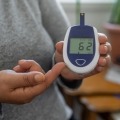How Does Menopause Affect Diabetes?
By Dawn Adams
 Dawn Adams, a midwife and diabetes researcher, shares her experience going through menopause with type 1 diabetes – plus tips for managing both.
Dawn Adams, a midwife and diabetes researcher, shares her experience going through menopause with type 1 diabetes – plus tips for managing both.
Menstruation, pregnancy, breastfeeding, menopause, assisted reproduction, and loss of pregnancy – these are life events experienced by many women with diabetes. Each one impacts glucose variability, but many of these areas are under-researched and under-reported, meaning substantial evidence is lacking to support these women.
Having experienced the glucose rollercoaster with menstruation, four pregnancies, breastfeeding, and type 1 diabetes, I’m now at the stage where menopause has become a topic close to my heart.
Over the past year, my conversations with other women with diabetes have shown a willingness to learn more about our collective perimenopause and menopause experiences. Online surveys, Tweetchats, WhatsApp groups, and menopause education have highlighted the moderate to severe impact of perimenopause (the transition to menopause) on the lives of women.
With the advent of continuous glucose monitors (CGMs), insulin pumps, and artificial pancreas systems, we can see such variabilities in our graphs and time in range data – something that would have been unimaginable 20 years ago.
Recurrent themes from the community include a lack of awareness and support from healthcare professionals regarding menopause and diabetes. Women have described feeling like they are “hitting a blank wall” when asking for guidance from healthcare providers to manage the effects of perimenopause on their glucose levels and insulin requirements. A common comment is, “I wish I had known more about the symptoms of perimenopause earlier.”
Menopause is defined as starting 12 months after the last menstrual period and can last for 10 years or more. Perimenopause starts 6-15 years earlier, meaning that in the U.K., where I live, roughly 13 million women are dealing with some sort of menopause. And a proportion of those women have diabetes.
What happens during perimenopause?
During perimenopause, menstrual patterns change. Periods may become lighter or heavier, or more irregular than usual.
The associated blood sugar fluctuations can also become increasingly challenging. The gradual decrease in estrogen during perimenopause can increase insulin resistance which, for people living with type 1 diabetes, means that blood glucose levels and insulin needs may become increasingly unpredictable.
This may also be the case if the womb or ovaries are removed for any reason. Estrogen and progesterone are two key hormones affecting perimenopause. Estrogen has a glucose-lowering effect, while progesterone has a glucose-raising effect. While research is ongoing in this area, some strategies may help minimize the impact of perimenopause on glycemic variability (more on that later).
What do menopause symptoms look like for women with diabetes?
Although not all women have the same experiences of menopause, many have said that it negatively affects their physical and emotional health. Perimenopause and menopause share many of the same symptoms including:
-
Hot flashes and night sweats
-
Mood swings
-
Disrupted sleep
-
Irritability
-
Weight gain
-
Dry skin or rashes
-
Reduced concentration
-
Loss of confidence
Menopause is also associated with metabolic dysfunction leading to weight gain, impaired insulin sensitivity, high blood pressure, and high cholesterol.
It can be confusing as women with diabetes transition to menopause as some of these symptoms aren’t that different from those of hypoglycemia; many find it hard to differentiate between the two.
It varies for each person, but many women find that menopause is an emotional rollercoaster. The symptoms can be mistaken for depression, so keeping a record of all symptoms experienced may help make appointments with a healthcare provider more productive, particularly if you are struggling emotionally.
Can hormone replacement therapy help?
There is little information for women and healthcare providers for this stage of life. Currently, the National Institute for Health and Care Excellence (NICE) offers no recommendations for women with type 1 diabetes, only advising that women with type 2 diabetes have specialist guidance if hormone replacement therapy (HRT) is deemed necessary.
There is conflicting advice about HRT treatments for women with diabetes. One woman I spoke to said that her healthcare provider knew nothing about HRT and diabetes. There is also a commonly held belief that HRT isn’t an option for women with diabetes.
The tragedy of this is that many women experiencing menopause have avoided any treatment, despite feeling that life is bleak due to hormone depletion. As women with diabetes, we know how difficult life is when essential hormones are absent or not functioning as well as they should.
Since the day we were diagnosed with type 1 diabetes, we have taken insulin; that was our first encounter with replacing a hormone. For some of us, thyroid insufficiency also means that thyroid hormone medication is necessary to keep us functioning. For those diagnosed with exocrine pancreatic insufficiency (which prevents food from being digested properly), pancreatic enzyme replacement therapy is prescribed.
All of this suggests that HRT may help with managing menopausal symptoms in women with diabetes. However, this should be carefully considered with a healthcare provider as the potential risks and benefits need to be evaluated on an individual basis.
Tips for managing menopause with diabetes
Despite the lack of guidance in this arena, there are some treatments and strategies women with diabetes can employ that may help manage symptoms of menopause:
-
Frequently monitor blood glucose levels. This may help with identifying patterns and adjusting your diabetes management plan if needed. CGMs have real-time glucose readings and alerts that detect and help you respond to glucose fluctuations more effectively.
-
Collaborate with your healthcare team. Work with your endocrinologist and a diabetes educator (if you have access to one) to develop a specialized plan for managing your diabetes during menopause.
-
Adjust your insulin. Hormonal fluctuations may require adjustments to insulin dosages or changes in the timing of insulin administration. Again, work with your healthcare provider who can help establish the right insulin regimen for you.
-
Eat a nutritious diet. Increasing your intake of fruit, vegetables, and whole grain cereals (while reducing consumption of processed foods and alcohol) may reduce menopause symptoms and fluctuations in blood sugar. There isn’t one recommended diet for diabetes and menopause, but incorporating foods rich in vitamins like folate will be beneficial.
-
Take supplements. Magnesium and vitamin D support bone health and improve sleep quality. While it’s always best to get vitamins from food, supplements may also work for alleviating some symptoms as an alternative to HRT. Note that there are some supplements people with diabetes should avoid.
-
Get exercise. Increasing physical activity, such as taking a walk after a meal, can improve insulin activity and carb absorption. Weight-bearing activities, such as dancing or low-impact aerobics, are known to be good for bone health. Find exercises that you enjoy, and if you can, invite family, friends, or other women experiencing menopause – it may improve mental health. Exercise also helps with balancing stress hormones and improving sleep, which can positively affect glucose levels.
-
Stay educated and informed. Keep updated with the latest research and information about menopause and diabetes management. Attend educational programs, workshops, or support groups to stay informed and learn from others' experiences. There are many free events and informative podcasts available across social media channels and in real-life settings.
The bottom line
Going through menopause with diabetes can be challenging. Everybody experiences this phase of life differently, and there is no single guaranteed treatment effective for all women.
For some, connecting with others via online communities and forums is helpful. Plenty of support groups exist on all social media platforms. If you prefer real-life meet-ups, look for menopause support groups in your local community (in the U.K. we even have menopause cafes). If a support group doesn’t yet exist in your area, consider starting one – it might just be the single most useful therapy you encounter.







